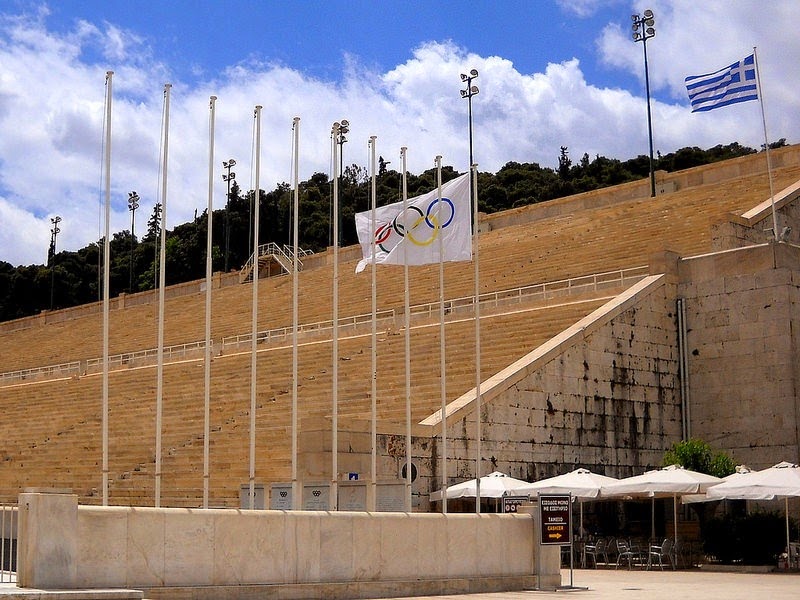
The first modern Olympic Games was held in the summer of 1896 in the Panathenaic Stadium in Athens, that saw the participation of 241 athletes from 14 nations. It was the largest international sporting event till date, and the Panathinaiko Stadium, which had a capacity of 80,000 at that time, overflowed with the largest crowd ever. The main events of the competition were athletics, gymnastics, weightlifting and wrestling, with the highlight being the marathon, held for the first time in international competition, and won by a Greek and the only sporting event to be won by the host. But the stadium’s history goes far beyond the 19th century. Indeed, it is one of the oldest stadiums in the world.

Photo: Kevin
The current Panathenaic Stadium is believed to be located on the site of an ancient stadium that hosted the Panathenaic Games, modeled after the ancient Olympic Games and held every four years in honor of the Goddess Athena. The games incorporated religious festival, ceremony and cultural events, aside from athletic competitions such as boxing, wrestling, mock infantry and cavalry battles, javelin throw on horseback, and a peculiar chariot racing where the driver had to jump out of the chariot, run alongside, and jump back in. These games started in 566 BC and continued into the 3rd century CE.
Originally the stadium was a small natural valley between the two hills of Agra and Ardettos, the slopes of which were fitted with wooden seating for the spectators. It was transformed into a proper stadium built completely with marble in 329 BC, by Lycurgus when he assumed responsibility for the finances of Athens.
Between 140 and 144 AD, the stadium was enlarged and renovated by Herodes Atticus, who spent part of his vast fortune on erecting splendid buildings in many sanctuaries and cities around the Roman Empire. Herodes changed the original rectilinear shape of the stadium to a horseshoe shape, characteristic of Greek stadia in Roman times, and installed rows of seats of white marble. A vaulted passage under the east retaining wall terminated at the back of the stadium. A triple-arched marble bridge spanning the the Ilissos River provided access to the stadium from the city. The whole space, and primarily the portico at the level of the sphendone, was adorned with statues of marble, bronze and even gold. The Athenians were justly proud of the Panathenaic Stadium, which was unrivalled in the world.

Photo: The Happy Rower
After the fall of the Roman Empire, the stadium gradually fell into disrepair. It wasn’t until 1,500 years later that Greek philanthropist and businessman Evangelos Zappas provided the funds to excavate and refurbish the stadium as part of a goal to revive the Olympic Games. Panathenaic could not be made ready in time for the first Olympic Games in 1859, and it had to be held in a city square in central Athens. But by the time for the 1870 games, Panathenaic was restored with wooden beaches having a seating capacity of 30,000. The stadium went on to host the 1875 and 1888-89 games as well.
Unfortunately, Evangelos Zappas didn’t live to see any of the games at the Panathenaic, but the immense fortune he left behind made it possible for the Panathenaic to undergo a second repair. This time the wooden seats were removed and replaced with white marble, just like in the original stadium. The International Olympic Committee was created in 1894 and the first modern Olympic Games was held here in 1896. Panathenaic held its second Olympic Games in 2004. The archery finals took place here, and the marathon race terminated inside the stadium. It’s unlikely, that the Panathenaic will ever held athletic events as its running tracks are curved at awkward angles that doesn’t conform to today’s standards. Today, the stadium regularly holds musical concerts.

Photo: tomfkemp

Photo: Robert Pittman

Photo: Visit Greece
Photo: Graham C99

Photo: Graham C99

Photo: Darren Foreman
The Olympic flame for the London 2012 Summer Games was handed over to the British delegation at the Panathenaic Stadium of Athens, Greece on May 17.

Photo: Emmanuel Eragne

Photo: alexcoltus
A rainy night at the Panathenaic Stadium devoted to Stelios Kazantzidis.

Photo: stefanos papachristou

Photo: Allan Watt
Source: wikipedia - www.panathenaicstadium.gr - www.stadia.gr Via Amusing Planet
Related Posts:
- Molyvos – a Tourist Capital of Historic Island of Lesbos, Hellas (Greece)
- Luxurious Comfort at Bill & Coo Suites in Mykonos, Hellas (Greece)
- A Vacationer's Paradise in Mykonos Island, (Hellas) Greece
- The Most Amazing Aerial Video of Hellas (Greece) You’ll Ever See
- Myrtos – the Most Picturesque Beach in (Hellas) Greece
- Corinth – an Eternal Center of Peloponnese, Hellas (Greece)
- Astypalaia – Undiscovered Gem in the Aegean Sea, Hellas (Greece)
- 49 Reasons To Love Hellas (Greece)
- Meteora, a Unique Place in Hellas (Greece)
- Santorini, Hellas: The Most Attractive Island in The World?
- Amazing Natural Pool Giola in Thassos Island, Hellas (Greece)
- The Beautiful Island of Zakynthos in Hellas (Greece)


0 comments:
Post a Comment